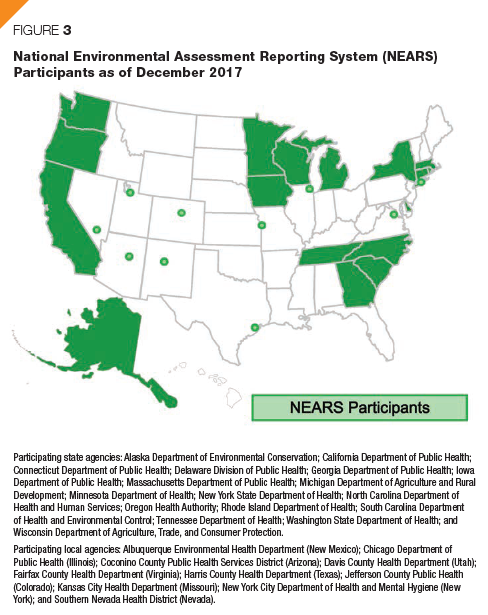Capturing Data on Contributing Factors to Outbreaks With the National Environmental Assessment Reporting System
Download the printable version of this article pdf icon[PDF – 495 KB].
Kramer A, Byrne M, Curtiss E. Capturing data on contributing factors to outbreaks with the National Environmental Assessment Reporting System. [commentary] J Environ Health. 2018;80(7):30–2.
Every year roughly 1 in 6 Americans (or 48 million people) get sick, 128,000 are hospitalized, and 3,000 die of foodborne diseases (Centers for Disease Control and Prevention, 2016). Furthermore, more than half of all foodborne illness outbreaks in the United States are associated with restaurants (Centers for Disease Control and Prevention, 2017). During outbreak investigations, environmental health and food safety staff conduct environmental assessments that identify contributing factors to help us learn how pathogens are spread in the environment. Data on contributing factors to outbreaks are critical to outbreak prevention. CDC’s National Environmental Assessment Reporting System (NEARS) is a surveillance system that captures environmental assessment data, including information about contributing factors.
What Are Contributing Factors?
In food safety, contributing factors are food preparation practices that lead to food getting contaminated, or that lead to pathogens growing/surviving in food. CDC identified 32 contributing factors, and they fall into three types: contamination, proliferation, and survival (Figure 1). The top contributing factors for NEARS-reported outbreaks in restaurants are
- When a sick food worker contaminates ready-to-eat food through bare-hand contact,
- When a sick food worker contaminates food through a method other than hand contact (such as with a contaminated utensil),
- When a sick food worker contaminates ready-to-eat food through glove-hand contact (such as touching a raw hamburger with gloves on and then touching the bun with the contaminated gloves), and
- When food handling practices lead to growth of pathogens (such as food not kept cold enough).
What Does NEARS Data Tell Us About Contributing Factors?
Contributing factors were identified for 194 of 297 (3 out of every 5) outbreaks reported to NEARS during 2009-2013 from eleven participating jurisdictions (Brown et al, 2017). Contributing factors were more likely to be identified for outbreaks if
- The pathogen linked to the outbreak was known.
- The outbreak establishment prepared all meals on-site.
- The outbreak establishment served more meals daily.
- Investigators quickly (within a day of learning about the outbreak) contacted the establishment thought to be linked with an outbreak to schedule their assessment visit.
- Investigators made multiple visits to the outbreak establishment to complete their assessment.
Timely and complete outbreak assessments are important to identifying contributing factors. These findings highlight the need for strong environmental health and food safety programs with the capacity to complete such assessments.
How Can State and Local Food Regulatory Programs Identify Contributing Factors?
To identify contributing factors for foodborne illness outbreaks, environmental health and food safety staff should:
- Use their knowledge about the pathogen linked to the outbreak to guide their environmental assessment (for example if hepatitis A is the suspected pathogen, the investigator would seek information on whether food workers were sick and their food handling practices).
- Conduct their assessment as soon as they learn of a potential outbreak.
- Conduct a complete assessment that may require multiple visits to the outbreak establishment.
In addition, investigators can take CDC’s free, interactive training on conducting environmental assessments (Figure 2). This training covers key activities of environmental assessments including
- Interviewing kitchen managers and food workers,
- Observing how restaurants prepare food (for example, food temperatures),
- Reviewing or collecting records (for example, records of food cooking temperatures and traceback records), and
- Sampling for pathogens in the restaurant kitchen.
Is Your Program Registered for NEARS?
NEARS is available for all state, local, tribal, and territorial food safety and environmental health programs (Figure 3). Participants provide critical data from environmental assessments to prevent and reduce future outbreaks. Your program can access and use your NEARS data at any time to
- Identify environmental causes of outbreaks in your jurisdiction.
- Take follow-up action to reduce or prevent future foodborne illness outbreaks.
- Develop or modify program policies or regulations.
- Help your program meet the Food and Drug Administration’s Retail Food Program Standards.
CDC and its national food safety partners use NEARS to analyze standardized data to understand how and why outbreaks occur and share findings to better respond to outbreaks and prevent future ones. In addition, regulatory agencies such as the U.S. Food and Drug Administration use information from NEARS to develop intervention strategies and recommended regulations such as the Food Code.
CDC and national food safety partners recommend that all food safety programs use NEARS to improve food safety in the United States. To learn more about NEARS, contributing factors, and environmental assessments, visit https://www.cdc.gov/nceh/ehs/nears/.
References
Brown, L.G., Hoover, E.R., Selman, C.A., Coleman, E.W., & Rogers, H.S. (2017). Outbreak characteristics associated with identification of contributing factors to foodborne illness outbreaks. Epidemiology and Infection, 145(11), 2254-62. Retrieved from: https://www.cdc.gov/nceh/ehs/docs/contributing-factors.pdfpdf icon.
Centers for Disease Control and Prevention (CDC). (2016). Burden of foodborne illness: Findings. Atlanta, Georgia: US Department of Health and Human Services, CDC. Retrieved from: https://www.cdc.gov/foodborneburden/2011-foodborne-estimates.html.
Centers for Disease Control and Prevention (CDC). (2017). Surveillance for foodborne disease outbreaks, United States, 2015, annual report. Atlanta, Georgia: US Department of Health and Human Services, CDC. Retrieved from: https://www.cdc.gov/foodsafety/pdfs/2015FoodBorneOutbreaks_508.pdfpdf icon.


